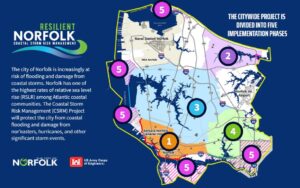popular
-
 Glen Pearson
Glen Pearson
Time to read: 2 minutes
Protecting Norfolk from the Risks of Climate Change: The Resilient Norfolk Initiative
Like many other coastal cities in the United States, Norfolk is vulnerable to the increasing risks of rising waters caused by climate change.
To address these threats, the city has over the last decade developed a Coastal Storm Risk Management Project, a comprehensive strategy that it calls Resilient Norfolk, which aims to protect the city from the impacts of climate change, economic changes, and other risks.
During a recent City Council meeting, a critical milestone was achieved as the city passed an ordinance to partner with the US Army Corps of Engineers on a series of projects that will significantly improve the city’s resilience. These projects are estimated to cost $2.6 billion in total, with $400 million being invested by the US Army Corps of Engineers as part of President Biden’s Bipartisan Infrastructure Law.
The Resilient Norfolk initiative involves a massive investment in infrastructure broken into five phases to be completed concurrently over the next decade.
Phase One of the Resilient Norfolk initiative focuses on safeguarding the downtown region by implementing a flood protection system consisting of floodwalls, a levee, surge barriers, and natural and nature-based features. This system will extend from Ghent through downtown and connect with the Ohio Creek Watershed project.One of the key components of the project is the construction of a 10-mile-long floodwall, which will run along the city’s waterfront from Old Dominion University to Naval Station Norfolk.

For Phase Two of the project, the focus will be on developing a system of floodwalls and storm surge barriers to minimize the impact of storm surges on the Pretty Lake area, specifically at Shore Drive.
In Phase Three of the project, a storm surge barrier is planned to be built from the Norfolk International Terminal (NIT) to the Lamberts Point area. This will serve to greatly reduce the risk of storm surge to the Lafayette River watershed.
In the fourth phase of the project, the focus will be on implementing a system of floodwalls, storm surge barriers, and tide gates to reduce the risk of storm surges from entering Broad Creek at I-264.
Phase Five of Resilient Norfolk will focus on property-specific flood mitigation projects. This will include elevating homes, filling basements, and implementing floodproofing measures in areas such as Berkley, Campostella, Elizabeth Park, Ingleside, NIT, and Willoughby. These projects will be tailored to individual properties and will help to further reduce the risk of flood damage in the city.

While these efforts represent a massive undertaking, it is just one part of the Resilient Norfolk initiative. Other projects aimed at increasing the city’s resilience include updating the city’s floodplain maps and creating a climate adaptation plan.
In coming months the city plans to gather feedback from residents through public meetings, surveys, and social media to ensure that the most vulnerable communities in the city are included in the planning process.
Construction is expected to begin in 2024 with completion expected in 2032.
Share This Story
Email This Story

Virginia Beach: Once Again Recognized as One of the Safest Cities in the Country
Each year, MoneyGeek evaluates cities across the nation to determine…
More Stories
Most Read
More Stories
Govtech.com Gives Norfolk 1st Place in Digital Cities Survey, Virginia Beach Falls to 3rd
Neighbor Virginia Beach falls to 3rd place in its own...
Farmers Markets of Virginia Beach
Where to find the freshest produce in the region.
SUSBSCRIBE TO THEVBJ
SUBSCRIBE TO THEVBJ
For Monthly Updates
More

Norfolk Is The 7th Best City For Dog Parks
It’s a great place for Fido to live.

The Best Beaches in Virginia Beach
Looking at the top beaches in the city.

Virginia Beach Called America’s 8th Best Run Big City
Researchers compared the country’s 100 largest cities on 37 metrics from such categories as financial security, schools, health, and safety.
SUSBSCRIBE TO THEVBJ
For Monthly Updates





